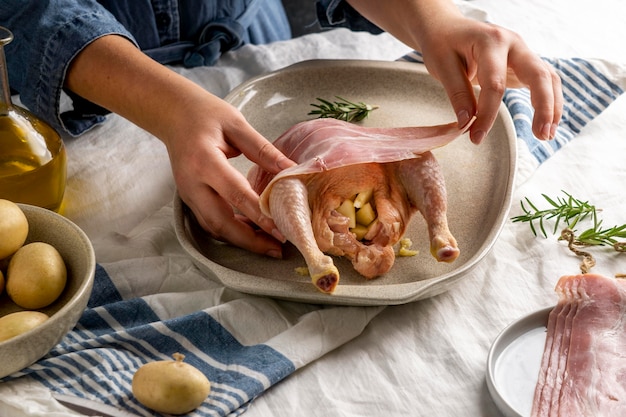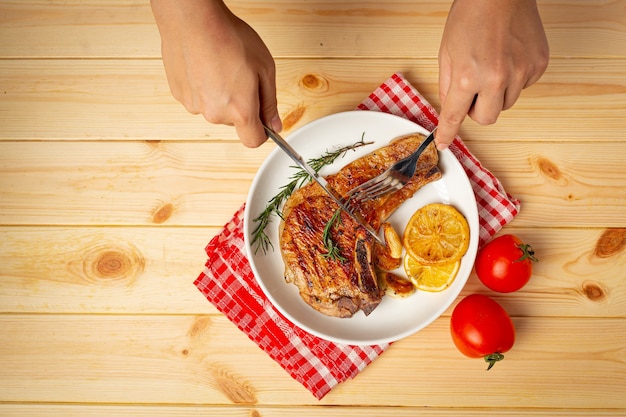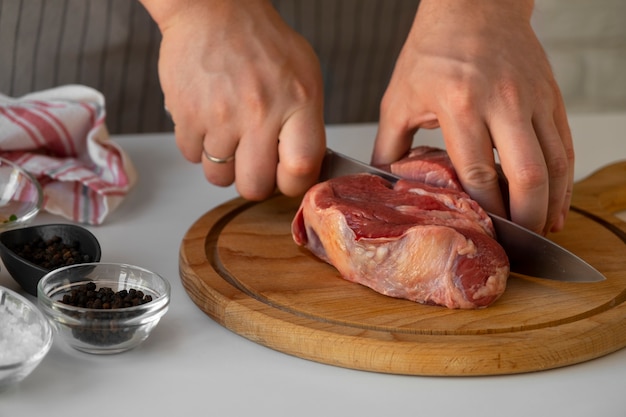There's something undeniably special about a roast leg of lamb. It's a dish that evokes memories of family gatherings, celebratory feasts, and those comforting Sunday dinners. But let's face it, tackling a whole leg of lamb can feel a bit daunting. It's not a recipe you throw together on a whim, is it? You want to get it right, you want it to be perfect, you want to impress your guests. Well, don't worry, because I'm here to guide you through every step of the way, from selecting the ideal cut to mastering the art of carving, so you can confidently create a truly unforgettable roast.
(Part 1) Choosing the Perfect Leg of Lamb: A Journey to Flavor

The foundation of a spectacular roast lamb lies in choosing the right cut. It's like picking the perfect canvas for a masterpiece; if you start with a subpar piece, you're setting yourself up for disappointment. So, let's delve into the world of lamb cuts and find the one that's destined to become the star of your meal.
Boneless or Bone-In? The Great Debate
This is a decision that sparks endless debate among culinary enthusiasts. A boneless leg is generally easier to work with. You can carve it into uniform slices, ensuring everyone gets a decent portion, and it cooks more evenly thanks to the absence of the bone. However, some purists believe that the bone adds an invaluable depth of flavor that simply cannot be replicated in a boneless cut. It's a personal choice, really. For me, the bone-in leg is a bit more rustic, offering a hint of old-world charm to the dish. If you're a beginner, the boneless leg might be a good place to start, but don't be afraid to step outside your comfort zone and explore the bone-in version once you're ready.
Fat: The Secret Ingredient
We all know fat gets a bad rap, but in the world of lamb, fat is a true friend. It's the key to achieving a roast that's incredibly tender and juicy. You want to see a good layer of fat covering the meat. Think of it as a natural, flavorful shield protecting the meat from drying out during cooking. Don't be tempted to trim off all the fat; a little marbling goes a long way! But, of course, if you're a little more health-conscious, you can trim away some of the excess fat, just make sure you leave enough to keep the lamb moist.
Size Matters: Feeding the Crowd
The size of your lamb depends on how many mouths you need to feed. For a small family gathering, a 1.5 kg leg should be sufficient. If you're expecting a larger crowd, you'll want to go for a 2.5 kg leg or even larger. Remember, lamb takes about 20 minutes per 500g to cook, plus an extra 15 minutes for resting. So, factor in the size of your leg and adjust your cooking time accordingly. It's always better to err on the side of caution and have a little extra than to find yourself short on portions!
(Part 2) Preparing the Leg of Lamb: Unveiling the Flavors

You've got your perfect leg of lamb, now it's time to unleash its full potential with the magic of preparation. Think of this stage as a culinary dress rehearsal, where we get everything ready for the grand performance of roasting.
Seasoning: The Art of Layering Flavor
Seasoning is a crucial step, and it's where you can truly make your lamb sing! There's no one-size-fits-all approach here; it's all about finding the flavour profile that speaks to your taste buds. Personally, I'm a sucker for a simple yet elegant blend of salt, pepper, and herbs. Fresh rosemary, thyme, and oregano are my go-to choices, but you can easily experiment with different herbs and spices to create your own signature blend. If you're feeling adventurous, a Moroccan spice rub or a Mediterranean herb mix can add a delightful twist. Whatever you choose, remember to season generously – the flavours will intensify during cooking.
Marination: A Symphony of Flavors
While not strictly necessary, marination can elevate your roast lamb to new heights. Think of it as a pre-show warm-up for the flavours. It adds an extra dimension of taste and helps to tenderize the meat. A simple mixture of olive oil, lemon juice, and herbs is a classic option. For a richer flavour, try marinating your lamb in a red wine marinade, or if you prefer a more delicate touch, a yogurt-based marinade is a great alternative. Let your lamb marinate for at least a few hours, or even better, overnight. It's a great way to let the flavours meld and create a truly remarkable roast.
(Part 3) Roasting the Leg of Lamb: A Culinary Dance of Heat

Here comes the moment you've been waiting for: the roasting process. This is where the magic happens, where the lamb transforms from a simple piece of meat into a culinary masterpiece. It's a delicate dance of heat, timing, and patience. Let's break it down step-by-step.
Oven Temperature: The Perfect Heat
Preheat your oven to 180°C (350°F). You want a good, steady heat to cook the lamb evenly and give it a beautifully golden crust. Think of it as a warm embrace that helps the meat to develop its characteristic flavour and tenderness. Always check your oven temperature with a thermometer, as ovens can have slight variations. It's a good habit to develop to ensure consistent results.
roasting time: The Clock is Ticking
A good rule of thumb is to cook a leg of lamb for 20 minutes per 500g, plus an extra 15 minutes for resting. This ensures the meat cooks evenly and achieves a perfect internal temperature. For medium-rare, aim for a final internal temperature of 63°C (145°F). If you prefer your lamb a bit more cooked, go for 68°C (155°F) for medium. Remember, the internal temperature will continue to rise slightly during the resting period. So, if you're aiming for a specific level of doneness, be sure to consider that factor when using your thermometer.
Resting: Patience is a Virtue
Once your lamb is roasted to perfection, resist the urge to immediately carve and serve. This is where patience truly pays off! Let your lamb rest for 15 minutes before carving. Think of it as a culinary time-out, allowing the juices to redistribute throughout the meat, resulting in a more tender and succulent roast. Cover the lamb loosely with foil to keep it warm and prevent it from drying out.
(Part 4) Carving the Leg of Lamb: A Masterful Performance
Now, let's talk about the grand finale: carving the roast lamb. It might seem intimidating at first, but with a little guidance, you'll master this art in no time. Think of it as a culinary ballet, where every cut is precise and graceful.
Tools of the Trade
First things first, you need a sharp carving knife. This is crucial for clean, precise cuts, ensuring a smooth carving experience. A dull knife will only lead to frustration and uneven slices, so make sure yours is sharp and ready for action.
Bone-in or Boneless? Two Approaches
If you're working with a bone-in leg, slice down both sides of the bone to remove the meat in two large pieces. Think of it as gently separating the meat from its skeletal companion. For a boneless leg, you can cut the lamb into slices, working across the grain. This ensures the meat is sliced in the direction of the muscle fibers, making it easier to chew and digest.
Don't Be Afraid to Ask
Carving a leg of lamb can feel daunting, but don't be afraid to ask for help if you're struggling. There's no shame in seeking guidance. And if you're feeling overwhelmed by the sheer amount of meat, a second pair of hands can always make the carving process go smoother.
(Part 5) Accompanying the Roast: A Culinary Ensemble
No roast lamb is complete without the perfect supporting cast of accompaniments! Think of it as a culinary ensemble, where each element plays a crucial role in harmonizing the flavors and creating a truly unforgettable dining experience.
Vegetables: The Sidekicks
Roasted vegetables are a classic companion for roast lamb, a match made in culinary heaven. Think of crispy potatoes, sweet carrots, earthy parsnips, or tender asparagus, all roasted to perfection and bathed in the savory juices of the lamb. You can even roast them with the lamb for extra flavour and a touch of rustic charm. If you're feeling adventurous, try a green bean and almond salad for a lighter touch, or a simple beetroot salad for a burst of color and sweetness.
Sauces: The Finishing Touches
A good sauce can truly elevate a roast lamb, like a dash of magic that transforms the dish into something truly extraordinary. You can use the pan juices to create a rich and flavorful gravy, or explore a more elaborate option like a mint sauce or a red wine jus. For a touch of Mediterranean flair, try a lemon and herb sauce, or for a creamy indulgence, consider a garlic sauce. The choice is yours, and each sauce will bring its own unique flavour and texture to the table.
(Part 6) Serving the Roast: A Celebration of Flavor
The time has come to unveil your culinary masterpiece! It's the moment you've been working towards, and you want to make sure your roast lamb takes centre stage. A little thought and care can go a long way in creating a visually appealing and memorable presentation.
Arrange the carved lamb on a serving platter, like a beautiful centerpiece for your culinary table. Let the golden-brown skin shine, the succulent meat tempt the eyes, and the enticing aromas fill the air. You can add a few sprigs of fresh rosemary or thyme for a touch of elegance, or even serve the lamb on a bed of roasted garlic cloves or a sprinkle of toasted pine nuts. The goal is to create a visual symphony that compliments the delectable flavours of your roast.
(Part 7) Leftovers: The Gift of Second Chances
Oh, the joy of leftovers! Roast lamb is a versatile ingredient that lends itself to a variety of culinary adventures. Don't be afraid to get creative with the leftover meat. It's a treasure trove of flavour waiting to be unleashed in new and exciting ways.
Lamb Sandwiches: A Simple Delight
Slice the leftover lamb and use it to create flavour-packed sandwiches with a touch of mustard, mayo, and crisp lettuce. It's a quick and easy lunch option that will satisfy your cravings.
Lamb Curry: A Spice-Infused Adventure
Dice the leftover lamb and add it to a curry for a flavorful and satisfying meal. It adds a delicious depth of flavour and texture to any curry recipe.
Lamb Shepherd's Pie: A Comforting Classic
Use the leftover lamb to create a comforting shepherd's pie. You can top it with mashed potato for a traditional approach, or try a creamy mashed sweet potato mixture for a twist on the classic.
(Part 8) FAQs: Addressing Your Culinary Concerns
Here's a chance to clear up any lingering questions you might have about cooking the perfect leg of lamb. Let's dive into some commonly asked questions and explore the answers that will set your culinary mind at ease.
Q: What temperature should I cook my lamb to?
A: The ideal internal temperature for medium-rare lamb is 63°C (145°F). For medium, aim for 68°C (155°F). But ultimately, it comes down to personal preference. Use a meat thermometer to ensure your lamb is cooked to your liking. It's a simple tool that can make a big difference in achieving perfect results.
Q: How do I know if my lamb is done?
A: The best way to check if your lamb is cooked is to use a meat thermometer. It's the most accurate and reliable way to ensure your lamb is cooked through. If you don't have a thermometer, you can check the meat by pressing on it. If it feels firm and springs back, it's cooked. If it feels spongy, it needs a little more time in the oven.
Q: What are some good wine pairings for lamb?
A: A robust red wine like Cabernet Sauvignon or Merlot is a classic pairing for lamb, complementing the rich flavours of the meat. If you prefer something lighter, a Pinot Noir or a Zinfandel can also work well. For a more adventurous pairing, try a Sauvignon Blanc or a Chardonnay. Remember, wine pairings are a matter of personal taste, so experiment and find what suits your palate best.
Q: Can I freeze leftover lamb?
A: Absolutely! Leftover lamb can be stored in an airtight container in the freezer for up to 3 months. Just remember to thaw it thoroughly in the refrigerator before using it.
Q: What are some tips for making the most of leftover lamb?
A: There are so many delicious ways to use leftover lamb! It's great in sandwiches, salads, curries, soups, or even shepherd's pie. Get creative and try different flavour combinations to find your favourites.
(Part 9) Final Thoughts: A culinary journey Concluded
Congratulations! You've successfully navigated the world of roast lamb, from choosing the perfect cut to mastering the art of carving. You're ready to create a truly unforgettable dining experience for yourself and your loved ones. Don't be afraid to experiment, have fun, and most importantly, enjoy the process! The satisfaction of crafting a delicious and impressive roast lamb is a reward in itself.
Remember, a good roast lamb is all about the flavour, the tenderness, and the joy of sharing a meal with those you cherish. So, go forth, embrace the challenge, and let your culinary journey begin!
Everyone is watching

Perfect Rice Every Time: The Ultimate Guide to Cooking Rice
Cooking TipsAs a self-proclaimed foodie, I've always been a bit obsessed with rice. It's the foundation of countless cuisi...

The Ultimate Guide to Cooking Asparagus: Tips, Techniques, and Recipes
Cooking TipsAsparagus. The mere mention of this spring delicacy conjures up images of vibrant green spears, crisp and burs...

Ultimate Guide to Cooking the Perfect Thanksgiving Turkey
Cooking TipsThanksgiving. Just the word conjures up images of overflowing tables laden with delicious food, the scent of r...

Prime Rib Roast Cooking Time Chart: Per Pound Guide
Cooking TipsPrime rib roast. Just the name conjures images of lavish dinners, crackling fires, and hearty laughter. It’s ...

Can You Cook Spaghetti with Gasoline? (The Shocking Truth)
Cooking TipsWe've all seen those crazy internet trends. You know, the ones that make you wonder, "Did someone actually try...
